Analysis of the Hydrochemical Characteristics and Genesis of Bosten Lake, China
Abstract
1. Introduction
2. Materials and Methods
2.1. Study Area
2.2. Acquisition and Testing of the Water Samples
2.3. Research Method
3. Results
3.1. Characteristics of the Hydrochemical Parameters
3.2. Spatial Distribution of the Ions and the TDS
3.3. Ion Source
3.4. Hydrochemical Type
3.5. Hydrochemical Evolution
3.6. Main Ion Ratio
4. Discussion
5. Conclusions
Author Contributions
Funding
Institutional Review Board Statement
Informed Consent Statement
Data Availability Statement
Acknowledgments
Conflicts of Interest
References
- Li, R.; Zhang, F.; Gao, Y. Surface hydrochemistry characteristics and controlling factors in the Ebinur Lake region during dry and wet seasons. J. Glaciol. Geocryol. 2016, 38, 1394–1403. [Google Scholar] [CrossRef]
- Asare-Donkor, N.K.; Ofosu, J.O.; Adimado, A.A. Hydrochemical characteristics of surface water and ecological risk assessment of sediments from settlements within the Birim River basin in Ghana. Environ. Syst. Res. 2018, 7, 9. [Google Scholar] [CrossRef]
- Pu, T. Hydrological Processes Study in a Typical Temperate Glacial Basin Based on Hydrogeochemistry and Isotopes. Ph.D. Thesis, Lanzhou University, Lanzhou, China, 2013. [Google Scholar]
- Tang, X.W.; Wu, J.K. Major ion chemistry of surface water in the Xilin River Basin and the possible controls. Environ. Sci. 2014, 35, 131–142. [Google Scholar] [CrossRef]
- Xie, G.J.; Zhang, J.P.; Tang, X.M.; Cai, Y.; Gao, G. Water quality in Bosten Lake (2010–2011) and its evolution trend in recent 50 years. J. Lake Sci. 2011, 23, 837–846. [Google Scholar]
- Zhang, M.; Dilinuer, A.J. Evaluation of ecosystem service value of constructed wetland on the west bank of the Bosten Lake. Trans. Oceanol. Limnol. 2021, 43, 169–174. [Google Scholar] [CrossRef]
- Peng, J.B.; Huang, Y.; Liu, T.; Zhang, Y.; Cheng, Y.; Jiang, L.X. Ecological water requirement of Bosten Lake wetland based on ecosystem service value. Chin. J. Hydroecol. 2020, 41, 21–30. [Google Scholar] [CrossRef]
- Peng, Y.F.; Li, Z.Q.; Yao, X.J.; Mou, J.X.; Han, W.X.; Wang, P.P. Analysis of Bosten Lake area change and its influencing factors based on multi-source remote sensing data and GEE platform. J. Geo-Inform. Sci. 2021, 23, 1131–1153. [Google Scholar] [CrossRef]
- Yang, X. Assessment of Water Production and Water Quality Purification Services in Arid Areas of Northwest China under the Background of Climate and Land Use Change; East China Normal University: Shanghai, China, 2020. [Google Scholar]
- Nueraminaimu, A. Study on Hydrogen-Oxygen Isotopes and Water Chemistry Characteristics in Bosten Lake Basin. Master’s Thesis, Xinjiang University, Ürümqi, China, 2006. [Google Scholar]
- Kou, Y.C. Analysis on Water Chemical Characteristics and Influencing Factors of Jinghe River. Master’s Thesis, Northwest A & F University, Xianyang, China, 2018. [Google Scholar]
- Prasanna, M.V.; Chidambaram, S.; Gireesh, T.V.; Jabir Ali, T.V. A study on hydrochemical characteristics of surface and sub-surface water in and around Perumal Lake, Cuddalore district, Tamil Nadu, South India. Environ. Earth Sci. 2011, 63, 31–47. [Google Scholar] [CrossRef]
- Mandal, A.; Haiduk, A. Hydrochemical characteristics of groundwater in the Kingston Basin, Kingston, Jamaica. Environ. Earth Sci. 2011, 63, 415–424. [Google Scholar] [CrossRef]
- Zhang, J.X.; Zhu, B.Q. Characteristics and influencing factors of hydrochemical composition in northern Xinjiang. Geogr. Res. 2022, 41, 1437–1458. [Google Scholar] [CrossRef]
- Wu, D.D.; Yao, Z.; Jia, F.C.; Wei, X.F.; Sun, H.Y.; Xie, N. Analysis on hydrochemical characteristics and genesis of groundwater in Hami Basin, Xinjiang. J. Arid Land Resour. Environ. 2020, 34, 133–141. [Google Scholar] [CrossRef]
- Dong, X.; Wu, C.Q. Theoretical model, system and method of urban competitiveness evaluation: A literature review. J. Hubei Univ. Econ. 2017, 15, 66–72. [Google Scholar] [CrossRef]
- Kresl, P.K. The Determinants of Urban Competitiveness: Asurvey, North American Cities and the Global Economy; Sage Publications: Thousand Oaks, CA, USA, 1995. [Google Scholar]
- Zhang, C.; Li, D.; Zhang, J.; Wei, X.M. Evaluation and evolution of urban competitiveness in Northwest China based on principal component analysis. J. Arid Land Resour. Environ. 2015, 29, 8–13. [Google Scholar] [CrossRef]
- Liu, P.; Song, J. Application of city competitiveness evaluation in new urbanization of Beijing-Tianjin-Hebei. J. Hebei Univ. Econ. Bus. 2019, 40, 65–72. [Google Scholar] [CrossRef]
- Zhang, J.X. Study on Competitiveness Evaluation of National Central Cities in Central and Western China. Master’s Thesis, Zhengzhou University, Zhengzhou, China, 2019. [Google Scholar]
- Dang, Y.P. Research on Comprehensive Evaluation of Urban Competitiveness in Beijing-Tianjin-Hebei. Ph.D. Thesis, Hebei University, Baoding, China, 2019. [Google Scholar]
- Gong, X.Y.; Weng, B.S.; Yan, D.H.; Yang, Y.H.; Yan, D.M.; Niu, Y.Z.; Wang, H. Potential recharge sources and origin of solutes in groundwater in the central Qinghai–Tibet Plateau using hydrochemistry and isotopic data. J. Hydrol. Reg. Stud. 2022, 40, 101001. [Google Scholar] [CrossRef]
- Lu, Y. Application of Multivariate Statistical Method in the Study of Groundwater Hydrochemical Distribution in Zhangye Basin; Hebei University of Geosciences: Shijiazhuang, China, 2016. [Google Scholar]
- Wang, Y. Land Use Change and Economic Center of Gravity Migration in Bosten Lake Basin; Xinjiang University: Ürümqi, China, 2015. [Google Scholar]
- Mechti, T.A.; Hamidi, I.; Zuppi, Y.M.; Li, J.T. Effects of land use change on ecological service value in Yanqi Basin. Res. Soil Water Conserv. 2012, 19, 137–141. [Google Scholar]
- Ayisulitan, M. Land Use/Cover Change and Its Driving Factors in Bosten Lake Basin; Xinjiang Normal University: Urumqi, China, 2014. [Google Scholar]
- Wang, L. Analysis of Runoff Sequence of Main Inflow Rivers in Bosten Lake Basin; Sichuan Normal University: Chengdu, China, 2008. [Google Scholar]
- Ge, Y.; Liu, L.; Gao, Z. Characteristics and geological significance of rare earth elements of Upper Permian in Zhina area. Shanxi Cok. Coal Sci. Technol. 2011, 35, 16–21. [Google Scholar]
- Shen, Y.F.; Ma, H.Y.; Yang, Y.D.; Cao, Y. Evolution characteristics and genesis of shallow fluorine-bearing groundwater in Wuqing Sag. Geophys. Geochem. Explor. 2021, 45, 528–535. [Google Scholar] [CrossRef]
- Sun, H.; Mao, Q.; Wei, X.; Zhang, H.; Xi, Y. Hydrogeochemical characteristics and formation evolutionary mechanism of the groundwater system in the Hami basin. Geol. China 2018, 45, 1128–1141. [Google Scholar] [CrossRef]
- Zhang, J.; Zhou, J.L.; Zeng, Y.Y.; Tu, Z.; Ji, Y.Y.; Sun, Y.; Lei, M. Hydrochemical characteristic and their controlling factors in the Yarkant river basin of Xinjiang. Environ. Sci. 2021, 42, 1706–1713. [Google Scholar] [CrossRef]
- Wu, C.J.; Li, N.; Wang, Y.T.; Ma, Q.M. Application of spatial interpolation method to seawater eutrophication evaluation in Jinzhou Bay. J. Water Resour. Water Eng. 2012, 23, 116–119. [Google Scholar]
- Yang, K.D.; Xie, H.X.; Sui, B. Research on spatial interpolation of rainfall based on GIS: A case study of Hunan Province. Res. Soil Water Conserv. 2020, 27, 134–138. [Google Scholar] [CrossRef]
- Gu, X.M. Geochemical Characteristics and Genetic Evolution Mechanism of the Alshanquan Group; China University of Geosciences: Beijing, China, 2018. [Google Scholar]
- Hu, C.C. Research on Distribution Characteristics of Karst Water and Water Chemical Composition in Gugui Mining Area, Huainan; Anhui University of Science and Technology: Huainan, China, 2018. [Google Scholar]
- Gibbs, R.J. Water chemistry of the Amazon River. Geochim. Cosmochim. Acta 1972, 36, 1061–1066. [Google Scholar] [CrossRef]
- Le, J.X.; Wang, D.C. Hydrochemistry of rivers in China. Acta Geog. Sin. 1963, 3, 3–15. [Google Scholar] [CrossRef]
- Zhang, T.; Wang, M.G.; Zhang, Z.Y.; Liu, T.; He, J. But lake basin surface water chemical characteristics and control factors. J. Environ. Sci. 2020, 9, 4003–4010. [Google Scholar] [CrossRef]
- Wei, X.; Zhou, J.L.; Nai, W.H.; Zeng, Y.Y.; Fan, W.; Li, B. Hydrochemical characteristics and evolution of groundwater in the Kashgar Delta Area in Xinjiang. J. Environ. Sci. 2019, 40, 4042–4051. [Google Scholar] [CrossRef]
- Yuan, T.; Qun, Y.; Li, L.K.; Shuang, W.J.; Zhou, Z.X.; Xiang, N.R.; Lei, T.X. Hydrochemical properties and elemental characteristics of natural water in Tibet. Acta Geogr. Sin. 2014, 69, 969–982. [Google Scholar] [CrossRef]
- Zeng, X.X.; Zeng, Y.Y.; Zhou, J.L.; Lu, H. Hydrochemical characteristics and Origin analysis of high sulfate groundwater in Kashgar River Basin, Xinjiang. Resour. Environ. Arid Areas 2022, 4, 128–135. [Google Scholar] [CrossRef]
- Luan, F.J.; Zhou, J.L.; Jia, R.L.; Lu, C.X.; Bai, M.; Liang, H.T. Hydrochemical characteristics and origin of groundwater in Balikun-Yiwu Basin, Xinjiang. Environ. Chem. 2017, 36, 380–389. [Google Scholar] [CrossRef]
- Shen, B.B.; Wu, J.L.; Jili, A.F.; Saparov, A.S.; Isanova, G. The balkhash lake basin water chemical and isotopic space distribution and environmental characteristics. J. Environ. Sci. 2020, 9, 173–182. [Google Scholar] [CrossRef]
- Zhang, J.T.; Shi, Z.M.; Wang, G.C.; Jiang, J.; Yang, B.C. Qaidam basin, the water chemical characteristics and evolution law of groundwater in big had. Geol. Front 2021, 28, 194–205. [Google Scholar] [CrossRef]
- Yang, J.Y.; Yang, Y.H.; Cheng, H.Y.; Cheng, F.X.; Kang, Z.K.; Ping, W.L. Hydrochemical characteristics and possible controls of the surface water in Kashi River Basin, Ili, Xinjiang. Environ. Chem. 2021, 40, 3815–3827. [Google Scholar] [CrossRef]
- Meng, Q. In the middle and lower reaches of shiyang river basin, shallow groundwater hydrochemical characteristics and its formation. J. Arid Zone Resour. Environ. 2021, 35, 80–87. [Google Scholar] [CrossRef]
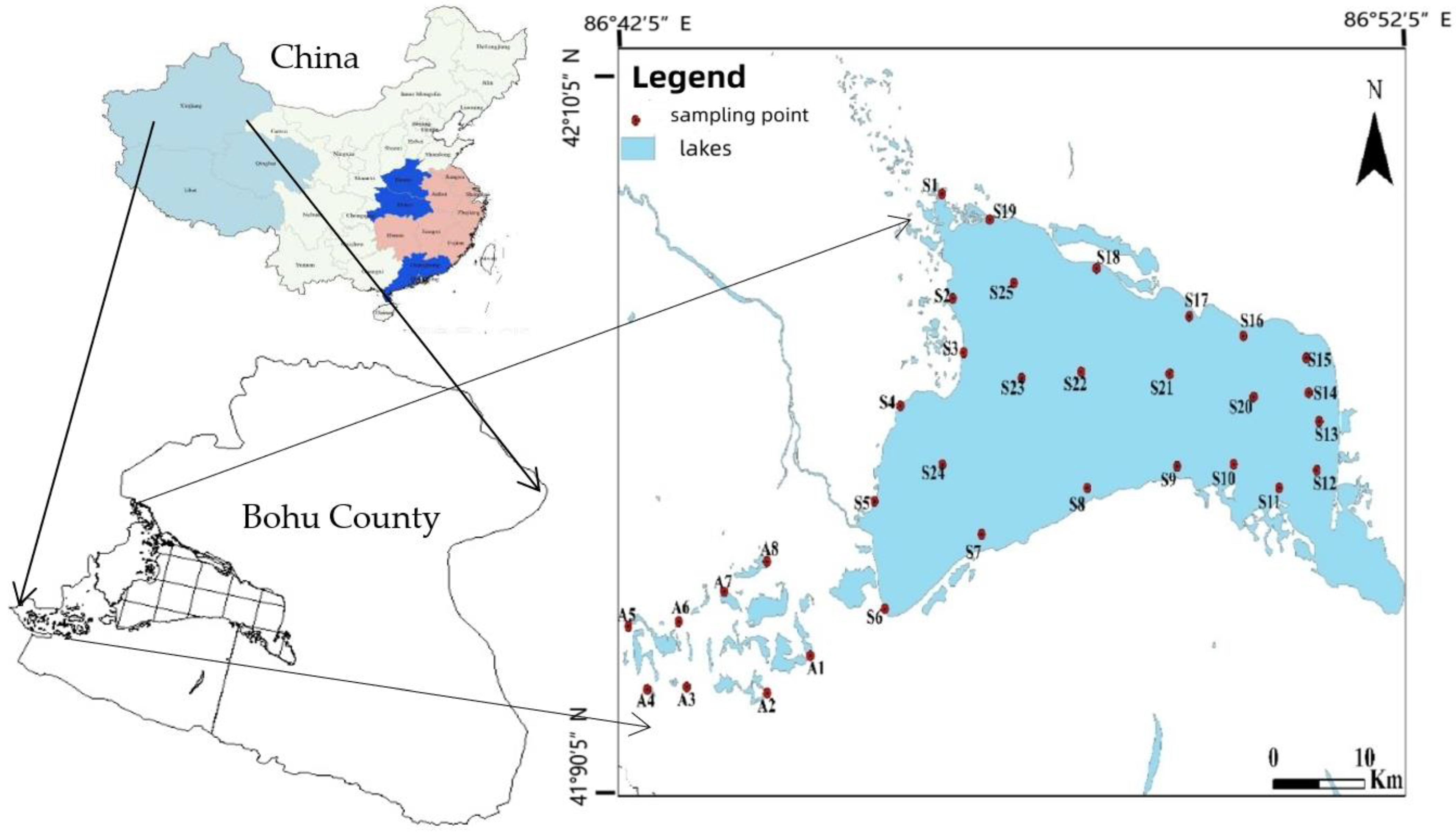
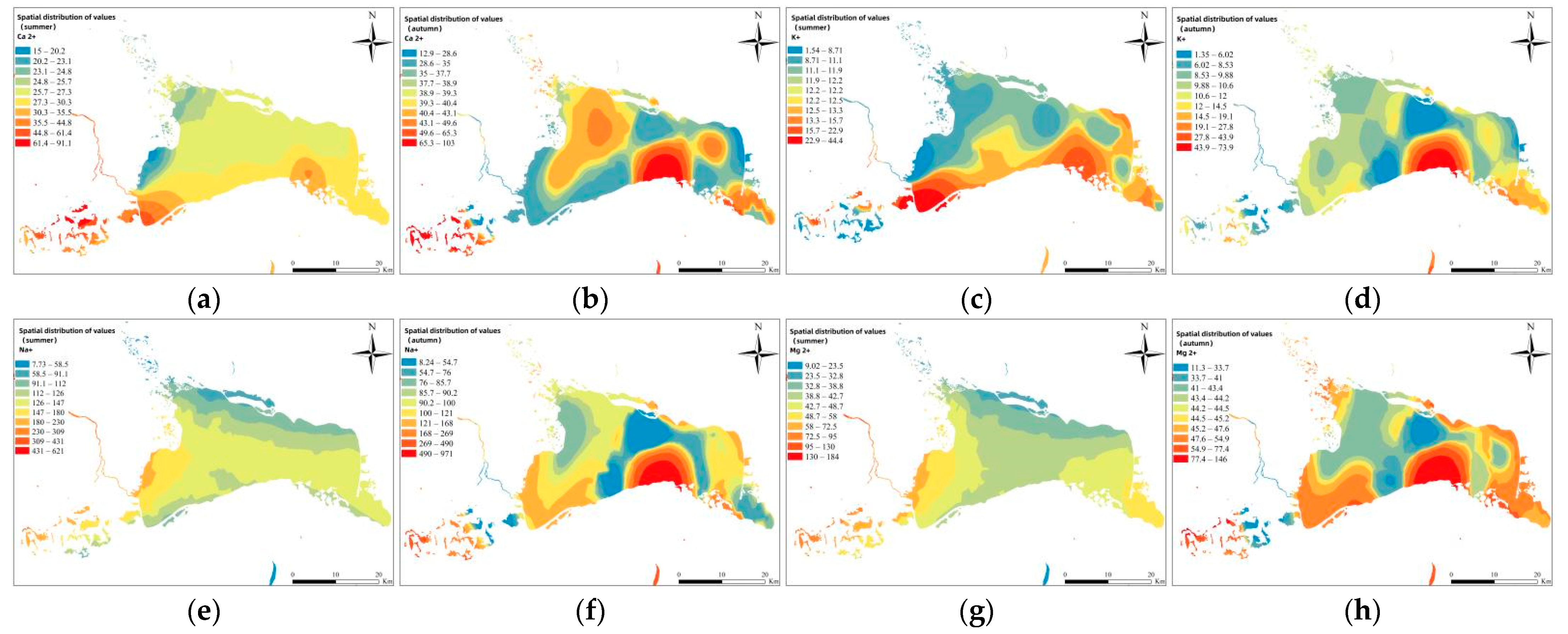
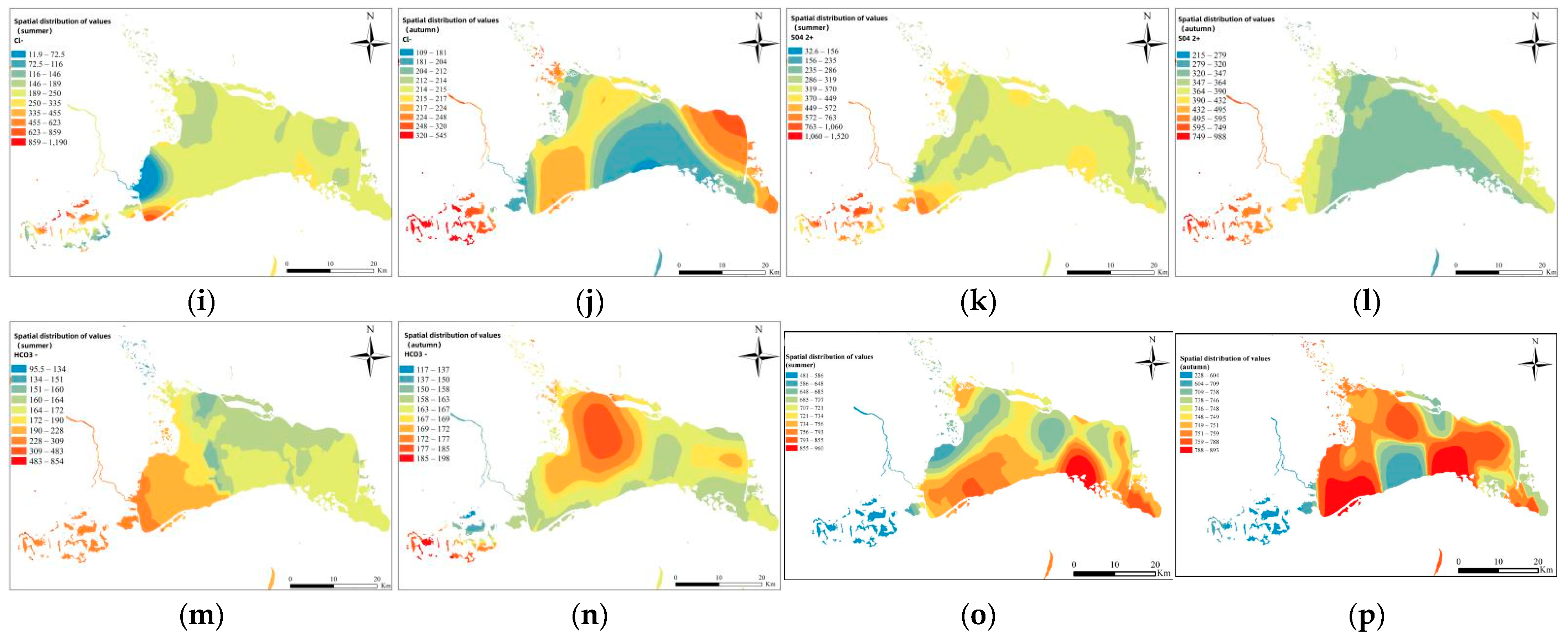
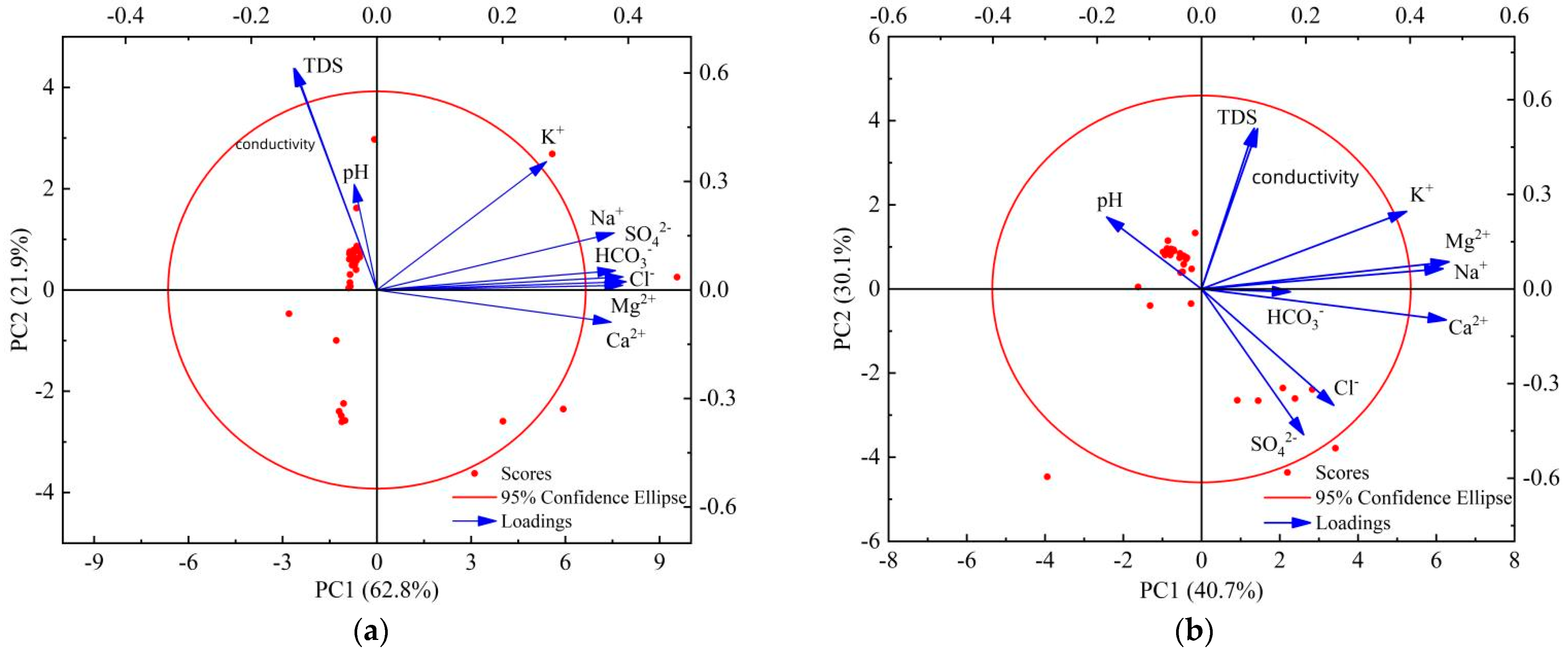
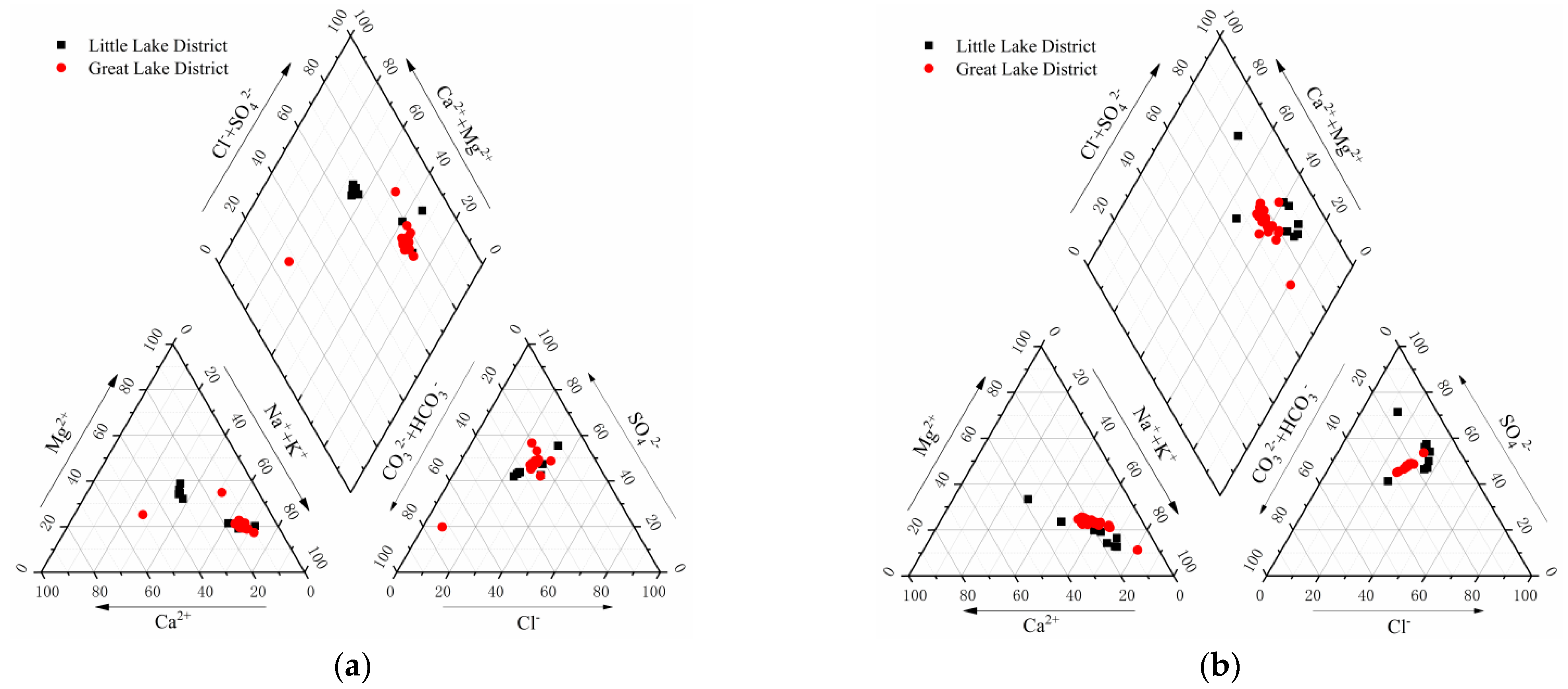

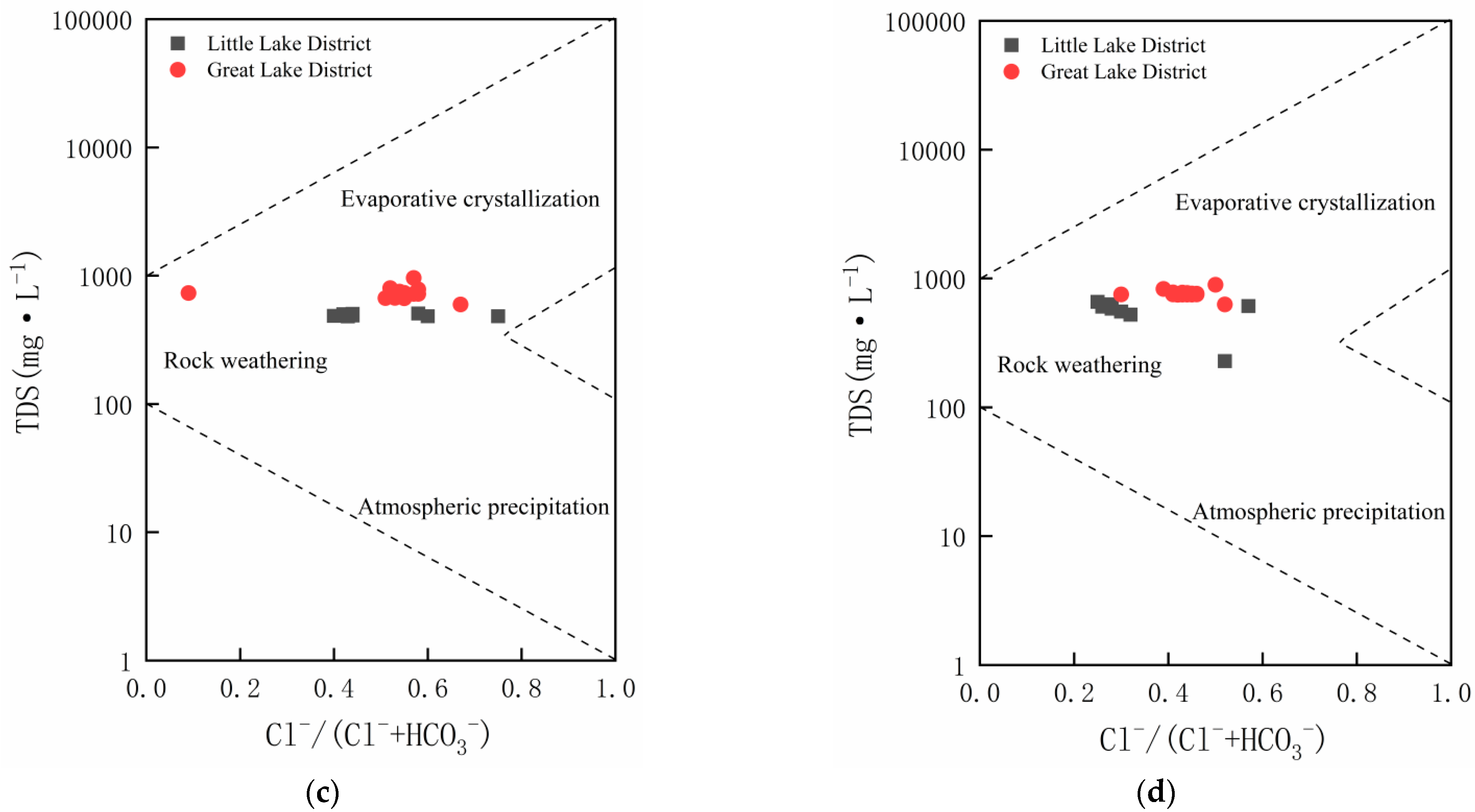
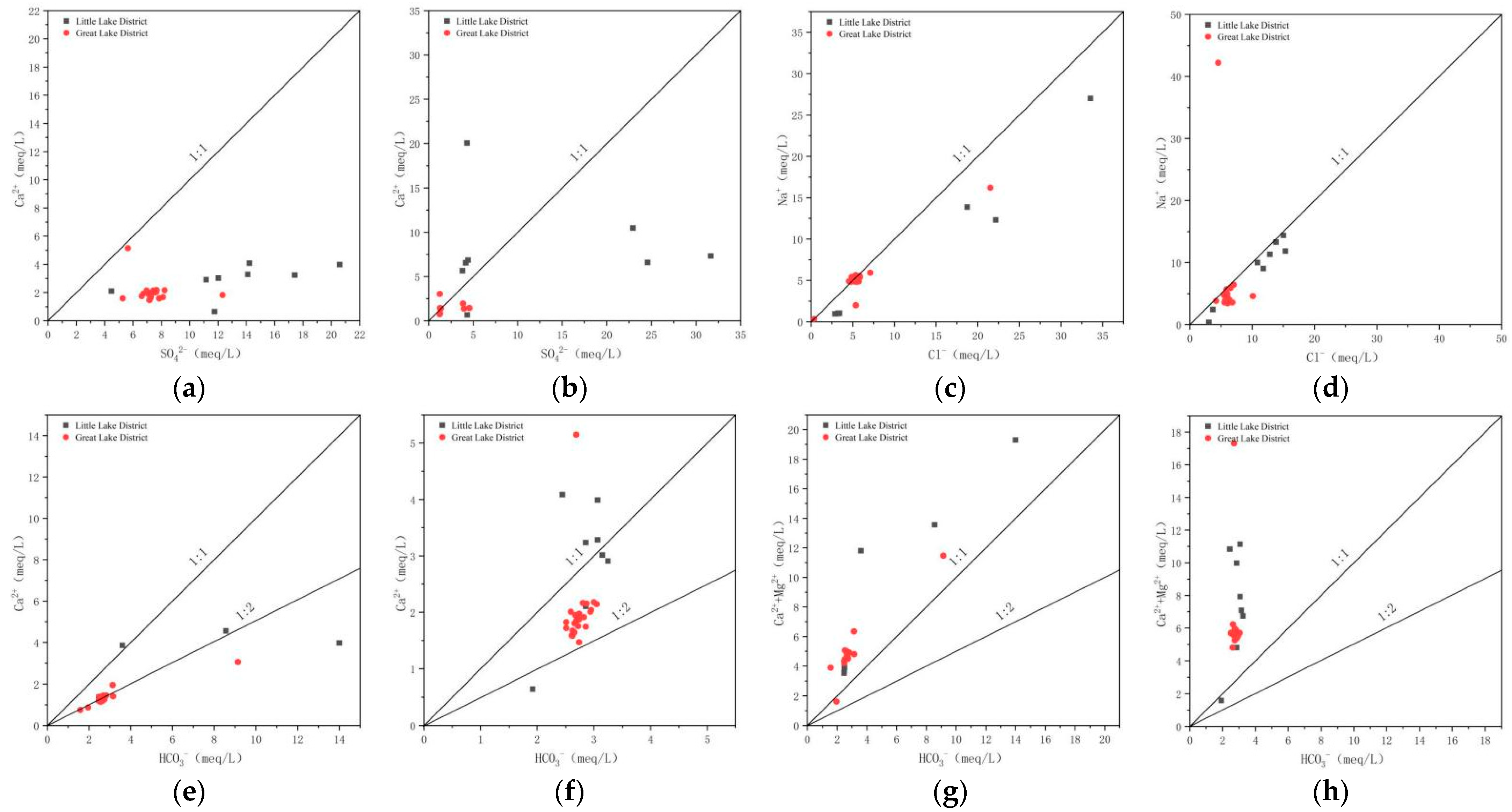

| Statistical Value | pH | TDS | K+ | Na+ | Ca2+ | Mg2+ | Cl− | SO42− | HCO3− | |
|---|---|---|---|---|---|---|---|---|---|---|
| Summer | Maximum value | 7.74 | 960 | 23.1 | 621 | 91.1 | 184 | 1190 | 1520 | 854 |
| Minimum value | 7.05 | 481 | 1.54 | 7.73 | 15.0 | 9.02 | 11.9 | 32.6 | 95.5 | |
| Mean value | 7.49 | 671.79 | 12.39 | 134.47 | 32.29 | 48.26 | 253.21 | 404.35 | 203.5 | |
| Standard deviation | 0.14 | 115.24 | 6.87 | 115.47 | 17.47 | 30.96 | 236.53 | 310.41 | 147.75 | |
| Autumn | Maximum value | 8.52 | 893 | 73.9 | 971 | 103 | 146 | 545 | 988 | 198 |
| Minimum value | 7.37 | 228 | 1.35 | 8.24 | 12.9 | 11.3 | 109 | 215 | 117 | |
| Mean value | 8.06 | 707.46 | 11.99 | 153.67 | 44.48 | 50.72 | 257.18 | 422.3 | 168.33 | |
| Standard deviation | 0.40 | 115.42 | 11.17 | 161.58 | 17.32 | 21.34 | 110.91 | 166.94 | 14.62 |
| Statistical Value | pH | TDS | K+ | Na+ | Ca2+ | Mg2+ | Cl− | SO42− | HCO3− | ||
|---|---|---|---|---|---|---|---|---|---|---|---|
| Summer | Great
Lake District | Maximum value | 7.69 | 960 | 44.4 | 373 | 61.1 | 101 | 763 | 963 | 557 |
| Minimum value | 7.16 | 596 | 1.54 | 7.73 | 15.0 | 9.02 | 11.9 | 32.6 | 95.5 | ||
| Mean value | 7.52 | 729.6 | 12.89 | 123.87 | 27.54 | 42.02 | 205.88 | 341.34 | 174.66 | ||
| Standard deviation | 0.11 | 60.92 | 7.00 | 57.57 | 8.02 | 14.01 | 120.03 | 147.63 | 80.21 | ||
| Little Lake District | Maximum value | 7.74 | 507 | 23.1 | 621 | 91.1 | 184 | 1190 | 1520 | 854 | |
| Minimum value | 7.05 | 481 | 6.82 | 22.5 | 25.0 | 27.1 | 102 | 183 | 150 | ||
| Mean value | 7.40 | 491.13 | 10.82 | 167.59 | 47.11 | 67.74 | 401.13 | 601.25 | 293.63 | ||
| Standard deviation | 0.19 | 9.82 | 6.17 | 207.84 | 27.73 | 53.29 | 396.07 | 527.42 | 243.35 | ||
| Autumn | Great
Lake District | Maximum value | 8.52 | 893 | 73.9 | 971 | 103 | 146 | 359 | 591 | 186 |
| Minimum value | 7.43 | 627 | 7.86 | 79.3 | 29.4 | 38.6 | 149 | 253 | 153 | ||
| Mean value | 8.17 | 758.4 | 12.77 | 135.9 | 40.1 | 49.27 | 216.72 | 354.4 | 167.08 | ||
| Standard deviation | 0.38 | 41.19 | 12.53 | 171.34 | 13.39 | 19.97 | 35.44 | 56.76 | 8.50 | ||
| Little Lake District | Maximum value | 8.05 | 657 | 13.8 | 331 | 81.7 | 85.8 | 545 | 988 | 198 | |
| Minimum value | 7.37 | 228 | 1.35 | 8.24 | 12.9 | 11.3 | 109 | 215 | 117 | ||
| Mean value | 7.72 | 548.25 | 9.53 | 209.21 | 58.18 | 55.24 | 383.63 | 634.5 | 172.25 | ||
| Standard deviation | 0.20 | 127.25 | 3.99 | 109.04 | 20.72 | 24.59 | 160.35 | 213.21 | 25.22 |
| HCO3− | Cl− | SO42− | K+ | Na+ | Ca2+ | Mg2+ | pH | ||
|---|---|---|---|---|---|---|---|---|---|
| Summer | Cl− | 0.944 ** | |||||||
| SO42− | 0.893 ** | 0.985 ** | |||||||
| K+ | 0.707 ** | 0.665 ** | 0.620 ** | ||||||
| Na+ | 0.911 ** | 0.961 ** | 0.943 ** | 0.684 ** | |||||
| Ca2+ | 0.824 ** | 0.924 ** | 0.955 ** | 0.545 ** | 0.835 ** | ||||
| Mg2+ | 0.945 ** | 0.987 ** | 0.971 ** | 0.631 ** | 0.967 ** | 0.889 ** | |||
| PH | 0.012 | −0.065 | −0.131 | 0.104 | 0.101 | −0.342 | 0.002 | ||
| TDS | −0.265 | −0.29 | −0.272 | 0.204 | −0.103 | −0.358 * | −0.275 | 0.211 | |
| Autumn | Cl− | 0.468 ** | |||||||
| SO42− | 0.136 | 0.889 ** | |||||||
| K+ | 0.02 | −0.073 | −0.142 | ||||||
| Na+ | 0.156 | 0.279 | 0.206 | 0.920 ** | |||||
| Ca2+ | 0.392 * | 0.582 ** | 0.482 ** | 0.651 ** | 0.830 ** | ||||
| Mg2+ | 0.15 | 0.350 * | 0.292 | 0.843 ** | 0.927 ** | 0.875 ** | |||
| PH | 0.022 | −0.199 | −0.268 | −0.217 | −0.307 | −0.367 * | −0.263 | ||
| TDS | 0.222 | −0.245 | −0.0483 ** | 0.381 * | 0.178 | 0.045 | 0.318 | 0.315 |
| Kaiser–Meyer–Olkin Measure of Sampling Adequacy | 0.674 | |
| Bartlett’s Test of Sphericity | Approx. chi-squared | 1220.246 |
| df | 153 | |
| sig | 0.000 | |
Disclaimer/Publisher’s Note: The statements, opinions and data contained in all publications are solely those of the individual author(s) and contributor(s) and not of MDPI and/or the editor(s). MDPI and/or the editor(s) disclaim responsibility for any injury to people or property resulting from any ideas, methods, instructions or products referred to in the content. |
© 2023 by the authors. Licensee MDPI, Basel, Switzerland. This article is an open access article distributed under the terms and conditions of the Creative Commons Attribution (CC BY) license (https://creativecommons.org/licenses/by/4.0/).
Share and Cite
Wang, X.; Aji, D.; Tuoheti, S. Analysis of the Hydrochemical Characteristics and Genesis of Bosten Lake, China. Sustainability 2023, 15, 4139. https://doi.org/10.3390/su15054139
Wang X, Aji D, Tuoheti S. Analysis of the Hydrochemical Characteristics and Genesis of Bosten Lake, China. Sustainability. 2023; 15(5):4139. https://doi.org/10.3390/su15054139
Chicago/Turabian StyleWang, Xiaolan, Dilinuer Aji, and Saimire Tuoheti. 2023. "Analysis of the Hydrochemical Characteristics and Genesis of Bosten Lake, China" Sustainability 15, no. 5: 4139. https://doi.org/10.3390/su15054139
APA StyleWang, X., Aji, D., & Tuoheti, S. (2023). Analysis of the Hydrochemical Characteristics and Genesis of Bosten Lake, China. Sustainability, 15(5), 4139. https://doi.org/10.3390/su15054139




